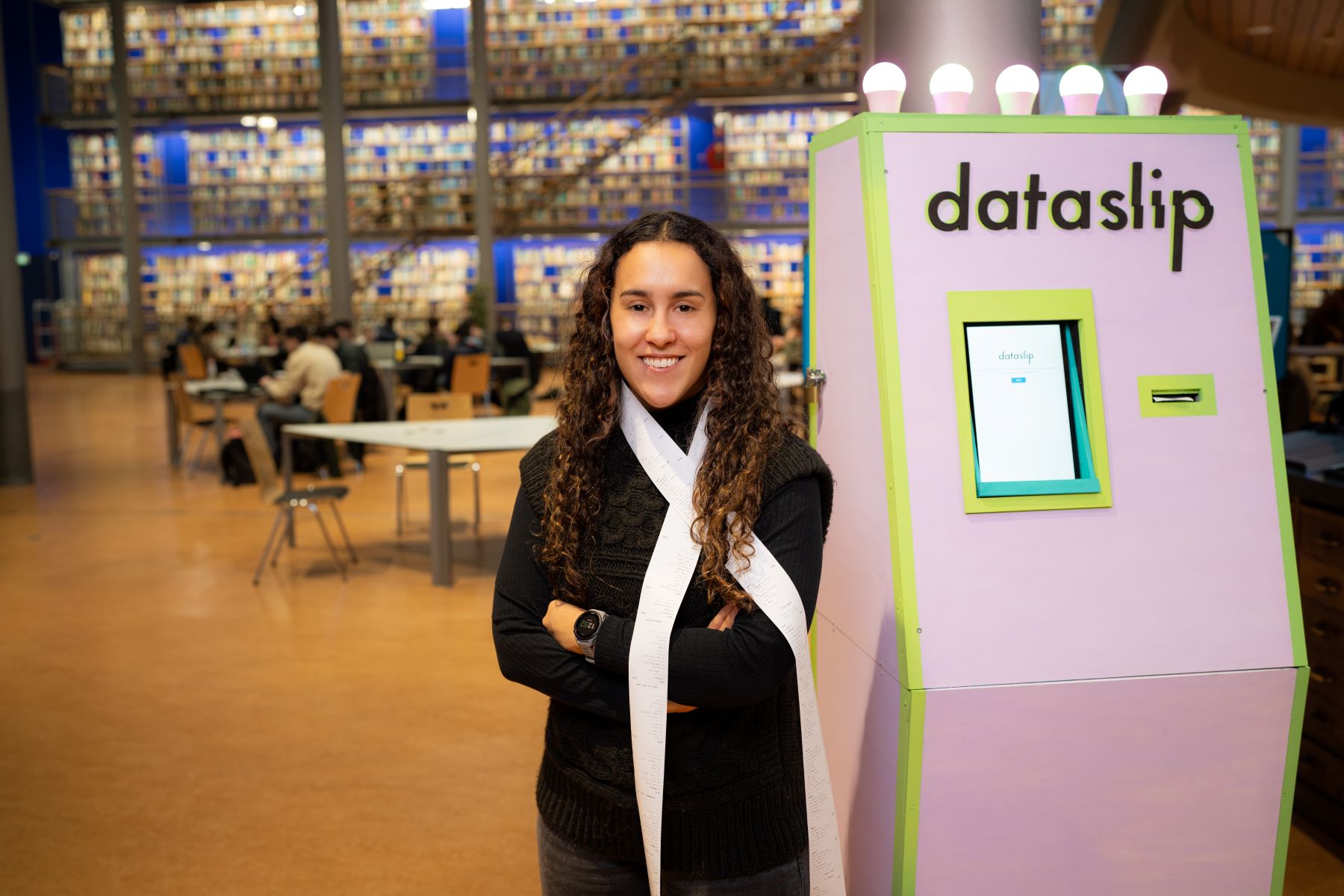Doctoral candidate Alejandra Gómez Ortega is travelling around campus with her ‘cash dispenser for data use’. Her mission: to show what data you leave online.
PhD student Alejanda Gómez Ortega shows what a 'data receipt' from her Dataslip machine looks like. (Photo: Marcel Krijger)
“The slip printer is quite slow, but that just enhances the effect,” smiles doctoral candidate Alejandra Gómez Ortega (Industrial Design Engineering) when TU Delft student Maarten (22) stands before her ‘Data Slip Machine’. He has just filled in a short series of questions on the screen of a device that looks a lot like a cash dispenser. Quietly humming, the Data Slip Machine starts printing out a long white slip of paper. Bit by bit, the black ink reveals more information, such as what his public transport card keeps, on the slip. It also shows what Spotify records about his taste in music.
The ‘data slip’, as Gómez Ortega calls the machine, makes people aware of the digital data about themselves that they leave behind every day. It could be when they use their smartphone, buy groceries, or travel by public transport. By answering a series of questions, users see what kinds of information are kept on them. They can then print it out. Or not. “Everyone now knows that all sorts of devices, apps and companies collect a lot of data, but it is often still abstract,” says Gómez Ortega. “You know that it is a lot, but you rarely have any idea what this data really is. You can get a clear idea in this slip.”
Surprised
The slip that the student Maarten ultimately prints out is almost as tall as he is. What does he think? “It’s not that bad,” he says. He is not really that concerned about the kind of digital information that is registered about him, or what profiles online companies have stored about him. “The European Union has a lot of legislation in this area. On top of that, the GDPR is constantly being amended,” he says. He also sees the advantages of collecting data. “A fitness tracking app like the one on my phone, needs a lot of user data to be able to work at all. In the end it helps improve the app.”
Not everyone responds like Maarten, says Gómez Ortega. She spends around one-and-a-half hours in the Library every day to answer any questions that people may have. “Some people are immensely surprised when they print out their data slip. They go and check the apps and the maps that they use.”
The researcher programmed the machine herself. Three IDE colleagues then helped her put the external frame together. They were Vasilis Millias, James Scott Broadhead and Wo Meijer. “It was a wonderful bonding experience,” she says. The help was very welcome as Gómez Ortega started working on her PhD at the Faculty of Industrial Design Engineering in the middle of the Covid crisis. “Everything was digital. I mostly felt confused and lost in the first year. It was only later that my research and social life really started.”
Data donation
As an aside, the machine is more an extension of her research than its main subject. Her research is on data donation. “I try to find ways in which people can share their personal information for research purposes while at the same time, making sure that there is a balance in how this process proceeds. That people know, for example, what information they give away and so that they get something in return.” Users of the Dataslip can also choose whether to share their data with Gómez Ortega, although her primary objective for her machine is to raise awareness. Up to now, 75 people have shared information. “I don’t know how many have not done so. If you select ‘no’ nothing is recorded, including the fact that someone has taken part and chosen not to share.”
While talking about her project, people hesitatingly come up to the machine now and then. The cash dispenser is very striking with its bright green and pink lights. Some people continue on their way. Once in a while someone stops to touch the screen, as did master’s student Saf (22). He says that he is careful about the apps and websites that he uses. “I don’t use Instagram or Facebook and I have installed ad blockers.” After filling in the questions, his personal data slip rolls out of the machine. It is a lot shorter than those of other users, notes Gómez Ortega. “Did you really fill in everything honestly?” she jokes.
The researcher hopes to be able to visit other faculties with her ‘cash dispenser’. “But it can be complicated to get permission for this,” she says. After her TU Delft journey she hopes that her project will be installed in other parts of the Netherlands. “I don’t much like the term ‘the general public’, but I do think that the machine can make the general public much more aware.” She does have one date for her tour outside TU Delft and that is in October when she will demonstrate her project at Dutch Design Week in Eindhoven. “I’m already looking forward to it.”
- The Data Slip Machine will be in the Library until Friday 24 February. The project will be in Pulse on Friday 3 March from 12:00 to 16:00.
Do you have a question or comment about this article?
a.m.debruijn@tudelft.nl


Comments are closed.